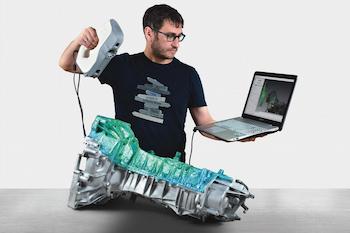3D scanning technology has brought us a whole new world. Enabling precise digital capture of physical objects. From engineering to health care, the applications of 3D scanning are vast and varied. In this blog post, our focus will be to describe what 3D scanning is, the 3D scanning process and the current 3D scanners offered as well as related software products.
What is 3D Scanning?
3D scanning is a technique that collects the details of an object or environment in three dimensions so that the shape and appearance are stored. This innovation, which may involve light sources such as Lasers, Structured Light or X-rays, is mainly applied to the measurement and data recording of the geometry of an object, which is then turned into a digital model and can be studied, changed, or manufactured. A concrete product is the one made by light, lasers or x-rays that reflect on it, and a digital model appears that can be summarized by, or the blueprint, be printed, and cast. The eventual 3D model is a highly reliable view of the master’s cut, possessing a lot of fiddly pieces and difficult geometries that have been transferred logic-ed to the laser and hence are now available as a 3D model.
The 3D Scanning Process
Numerous steps are included in the process of 3D scanning, from the first scan to the final model creation. These are the main steps that are to be done:

- Preparation: The object or environment has to be cleaned before scanning can begin. It may involve cleaning the surface, setting up reference points, or ensuring the object is stable.
- Scanning: The process’s heart is scanning. It involves the 3D scanner capturing the geometry of the object. The scanner shines light or shoots lasers onto the item and then measures what is reflected back to form a digital picture.
- Kreon Arm 3D Scanner: Known for its precision and flexibility, ideal for industrial applications.
- Artec Leo 3D Scanner: A portable, wireless scanner with real-time onboard processing, perfect for capturing objects in various environments.
- 3D Scanner Artec Space Spider: It is well-known for its precision and detailing, especially for small objects and intricate details.
- Artec Eva 3D Scanner: Giving you the obvious advantage of being able to capture outline information freely with a handheld Scanner that does not need targets or markers for tracking. Tracking is by geometry, color/texture and/or gyroscope.
- Artec Micro Automated 3D Scanner: Is an automated 3D Scanning with 2 axis (Rotation and tilt) that can scan parts within 5 inches without any manual work. The output is .STL, OBJ, PLY and many more general industry options.
- Artec Ray 3D Scanner: Ideal for precise capture of huge objects such as wind turbines, ship propellers or airplanes, bridges or factory floors, forensic scenes or archeology sites, this professional LiDAR solution produces 3D scans of the highest quality, whether your application is reverse engineering, inspection, creating true-to-life digital twins, documenting crime scenes, or making change-over-time assessments of civil infrastructure.
The wireless Ray II’s lightweight portability makes it a cinch to take anywhere you need: vehicles can be captured in minutes, aircraft and full-sized buildings in just a few hours. - Shapify Booth 3D Scanner: A machine fine-tuned to the art of quick and efficient full-body 3D scanning.
- Data Processing: Specialized software is used for processing the raw data gathered during scanning. This process consists of aligning numerous scans, removing noises, and creating a 3D model that is coherent. Some of the most well-known software options are:
- Artec Studio Professional: This is an amazing software for 3D data scanning, processing, and analyzing.
- Design X: A perfect tool to turn 3D scan data into CAD models.
- Geomagic Control X: This is a tool for quality control and inspection of 3D models.
- Geomagic Wrap: This software assists in the conversion of a scanned image to a 3D model format that can be used for further processing.
- Geomagic for SolidWorks: This is a product that incorporates 3D scanning capabilities directly into the SolidWorks environment.
- PolyWorks: This is an extensive software for 3D metrology and analysis.
- Post-Processing: The final steps are the checks and refinements of the 3D model. This process may include mesh editing, integrative texture, and preparation of the model for its use such as 3D printing, virtual reality, or analysis.
3D Scanning in the context of its applications
3D scanning is a versatile tool which is universally applicable in a number of the different fields.
Manufacturing and Engineering: This Laser 3D Scanning process is used for reverse engineering, quality control, and prototyping.
Healthcare: It provides an opportunity for creating custom prosthetics, orthotics, and anatomical models to facilitate surgery.
Cultural Heritage: 3D scanning is used to save and also recover ancient artifacts and historical sites.
Entertainment: 3D scanning is almost processed in film and game design where it produces characters and environments that are seemingly real. Architecture and Construction: Through this instrument technology, it is now possible to document as-built statements, as well as, plan for renovations.
Conclusion
3D scanning is a mind-bending technology that links the digital and the real worlds, enabling the near-perfect digital capture of objects and environments. With breakthrough devices like Kreon Arm, Artec Leo, and Artec Space Spider and software such as Design X and Geomagic Control X, the horizon is open. With new 3D scanning tech topics such as, robotics, artificial intelligence, and automation, 3D scanning is frequently employed in manufacturing, healthcare, and entertainment, not only does it facilitate innovation, but also the process optimization and precision engineering are also achieved.
Visualize turning to the future with 3D scanning and check how this innovative technology would flip the table of your business.

